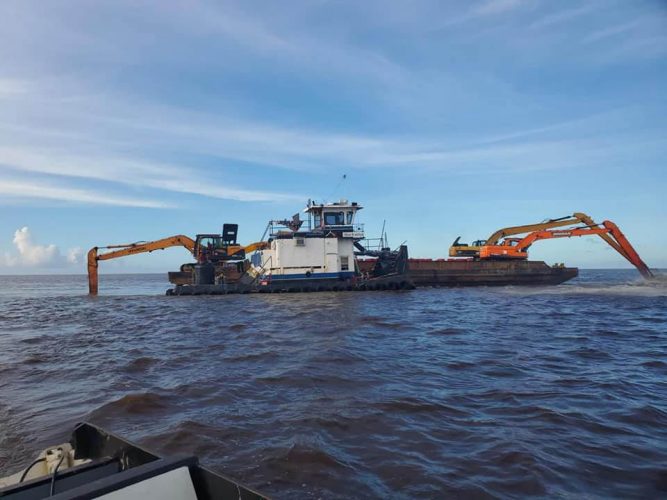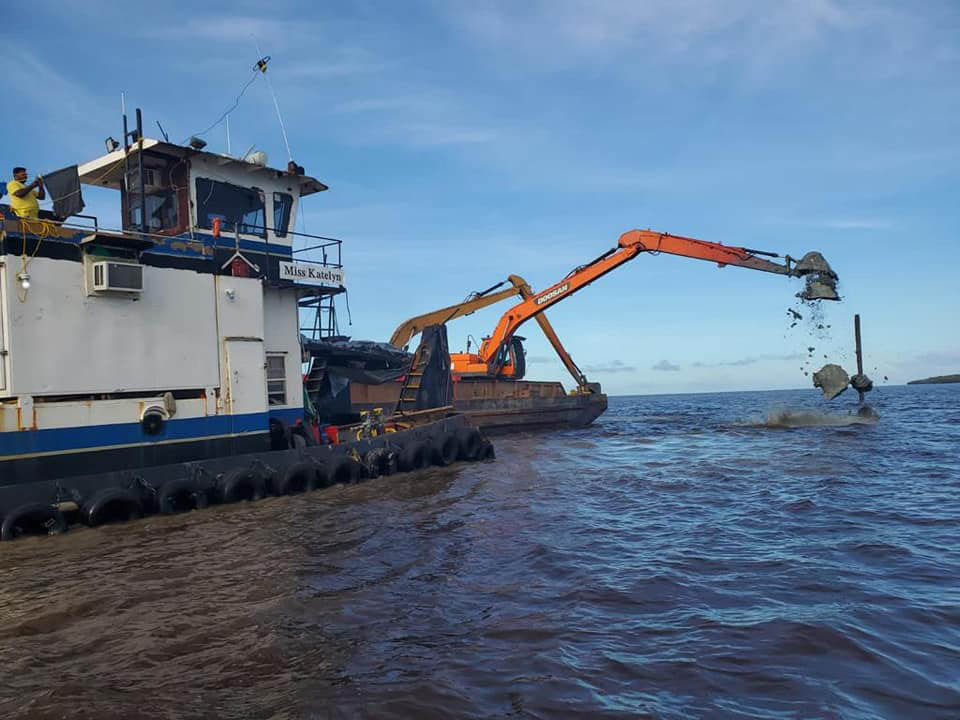Dredging along the Pomeroon River mouth is progressing and while it is viewed as a preventative measure against flooding, Gaico Construction and General Services Inc’s Chief Executive Officer (CEO), Komal Singh said the activity will open up opportunities for more commerce.
The works along the river mouth have progressed approximately “quarter way” and the CEO of Gaico, the company contracted to dredge the mouth, said that they should complete the project by September.
He said that the mouth of the river is extremely shallow with a draught of just 1 metre. The company is utilising excavators to clear the river mouth.

“I see a lot of people asking why we are using excavators. We are doing this because of the depth of the river mouth. We cannot take the hopper there because of the depth. The pontoon on which the excavator is on, is floating 2 to 3 feet underwater. We cannot use the hopper there because it is bigger and heavier.”
The dredging exercise will allow the river mouth to be open to a depth of three metres.
Singh added that the characteristics of the mud being removed indicate that no dredging works have been done in over 20 years.
“From the hydrographic survey done, the remainder of the river is over 16 to 18 feet deep, but at the mouth there is heavy siltation. This has contributed to excess water being backed up on lands resulting in catastrophic floods for residents along the Pomeroon River”, he said.
A major contributor to the siltation has been coconut husks. According to the CEO, while much of the coconut husks have degraded over time, the excessive dumping has contributed to the siltation in the river mouth.
The company is engaged in backhoe-style dredging where the excavators are removing the mud and placing it approximately 25 to 30 feet away from the cleared channel.
“Persons might also question this move but it is the only thing we can do. Due to the depth at the river [mouth] if we bring an additional pontoon, load it with the mud excavated, the pontoon is likely to be grounded… It is a very hard mud in that area…”
However, he opined that this cannot be a one-time exercise and to fully encourage cargo transportation activities, there will be a need for additional dredging, taking the project into phases two and three.
With the continuation of works on the river, he said the channel can be extended to 80 feet in width and the depth can be increased to approximately five metres. However, the company has only been contracted to execute phase one of the project.
“It is quite costly to move cargo from the Pomeroon because you have to discharge at Charity wharf, come to Supenaam, then to Parika and Georgetown. That has been incurring a lot of expenditure [to farmers] for transporting their goods,” the CEO added.
He contended that neither marine life nor the fishermen’s livelihoods are impacted by the activity since the area is not considered a fishing ground as it is actively traversed. Speed boats currently operate on the river transporting people and cargo between regions One and Two.
In April, the National Drainage and Irrigation Authority on behalf of the government signed a $569.3 million contract with Gaico Construction for the dredging of the Pomeroon River mouth.
Minister of Agriculture, Zulfikar Mustapha, back in April had said that the dredging of the Pomeroon River mouth will bring relief to farmers in the area who have been affected by floods time and time again.
Major flooding last year hit farmers and many are still trying to recover from that episode. Most of them had received cash relief from the Ministry of Agriculture and re-invested the monies into their farms.
`Like a cement floor’
Former Assistant Director of Public Prosecutions, Judith Gildharie, in a letter to Stabroek News in March had highlighted the need for sustainable solutions to aid farmers.
“Farmers need long-term, sustainable solutions now! The experts need to find these solutions quickly and then the government can find the funding necessary to implement them.”
She pointed out that farmers depend on what they grow to survive and constant flooding and decimation of their crops leave them frustrated, afraid, insecure, and incessantly worried about providing for their families.
“…some engineers had gone to the area with the aim of dredging the estuary and I recall them telling my parents that it was a difficult task attributable primarily to the fact that the river bed had apparently become so hardened, ‘like a cement floor’ caused by the countless coconut husks that had been thrown into the river and which had ultimately settled at the bottom,” Gildharie remarked.
Back in July, 2019, the Environmental Protection Agency (EPA), headed then by Dr Vincent Adams, had fined a Pomeroon coconut company $1 million for its dumping of shells and husks into tributaries of the Pomeroon River.
Regional Chairman, Vilma Da Silva, while acknowledging this was a fact, said that they have been working along with the EPA to educate farmers and producers of coconut products about the dangers of coconut pollution.
She stated that while this is a problem, the region is currently brainstorming ideas and working with government to find solutions to combat coconut waste.
Last December, these communities among others, inhabited by over 2,000 persons, faced severe flooding for a second time in 2021.
Da Silva described the situation as “sad,” alluding to the fact that farmers were re-entering their fields after the flooding in May.
Farmlands and homes in the Pomeroon River in May last year had been covered in floodwater. Water levels in the region climbed to unexpected heights and caused major disruption to livelihoods.
The floods had been described as the worst in approximately four decades and for most of the villagers it was the first time they had had such an experience. In Karawab, water levels were close to 14 feet high, and villagers said that they were surviving on hampers distributed by the government.
Communities like Siriki, Karawab, and others in the Upper Pomeroon and Akawini Creek in the Lower Pomeroon were amongst the hardest hit by the flooding.
Former Regional Executive Officer of Region Two (Pomeroon/Supenaam), Devanand Ramdatt, had said, “We’ve never seen anything like this before. The rate at which the entire Pomeroon was flooded, is something that even the elderly people of Pomeroon are also saying that they’ve never seen anything like this before. Apart from the Pomeroon, two Amerindian communities, Kabakaburi and St. Monica… also received hampers.”
During President Irfaan Ali’s visit to the flood-hit communities, he had promised “to do everything to secure back your livelihood. We are going to do everything to get you back to the farmland; we are going to do everything to help back the household.”








